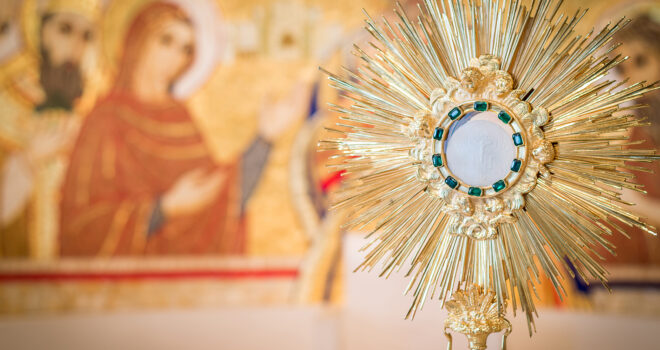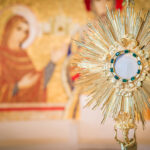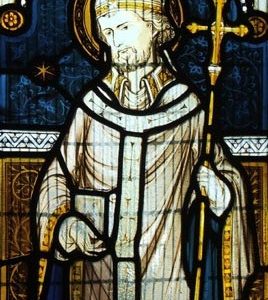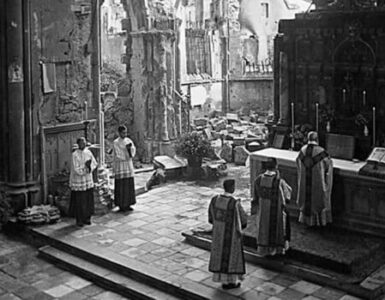The three-year Eucharistic Revival launched by the United States’ Bishops on the Feast of Corpus Christi last year is not only a wonderful opportunity to reencounter our Lord in the Most Holy Sacrament, but also a welcome occasion to clear up some murkiness in our Christology. This was made startlingly clear to me while listening to a series of reflections offered by theologian Dr. Lawrence Feingold in Saint Louis last year.
Having contracted COVID, Dr. Feingold was forced to deliver his first presentation virtually from home while his audience was seated in a nearby chapel at the Rigali Center. This set the stage for his explanation of the difference in Jesus’s presence in the two locations: “I’m in my basement here, and Jesus is present here, but in his divinity, not in his humanity; but where you are (i.e., in the chapel) Jesus is present there not just as God, but as Man.” Although this sounds reasonable, the claim is, at best, heterodox, but I am afraid it may even be worse.
In the Easter season we are celebrating – with the appearances of the Risen Christ, His ascension into heaven, and His sending of the Holy Spirit – we are reminded of the mystery of the God-made-man and forced to refine the doctrinal precision of our belief in the hypostatic union and how it relates to the sacraments. At no point in the history of the Church do we learn that the risen Christ can be present anywhere only as God. No orthodox position has ever held that Jesus, once incarnate, could ever be present only in His divinity or only in His humanity. I do not want to pick on Dr. Feingold, for I have heard similar claims made by laity, clergy, and theologians (but not yet by any Bishop, thank God!).
What the Church actually teaches is that the Eucharist contains “truly, really, and substantially” (vere, realiter, et substantialiter) the body and blood, soul and divinity of our Lord Jesus Christ (CCC 1374). This does not mean that other presences of Christ – such as in the Word, in the prayer of the Church, in the poor, in the sick, in the other sacraments, and in the sacred minister – are not “real,” but simply that Christ is foremost (maxime) present in the Eucharistic species (CCC 1373). Moreover, this does not imply that, outside of the Eucharist, Jesus is present only “in his divinity.”
In fact, the claim flirts with disaster when placed under the light of the Council of Chalcedon in 451, where the fathers confessed that “one and the same Christ, Lord, and only-begotten Son, is to be acknowledged in two natures without confusion, change, division, or separation (italics mine).” That Jesus is present – wherever and however He is present – in both His divine and human natures is a doctrinal given. How he is present in that indivisible and inseparable union of two natures – whether in the human soul, in the sacraments, or in Dr. Feingold’s basement – is another matter. The one thing we are doctrinally obliged to confess is that, in all cases, Christ is present as one person (prosopon) in an indivisible hypostatic union of two natures.
Dr. Feingold is right to point out the difference between Christ’s presence in his basement and Christ’s presence in the Eucharistic species. Pope Paul VI teaches this in his eloquent Encyclical Letter Mysterium Fidei (1965), in which he affirms the real, substantial presence of Christ in the Eucharist without mitigating the other modes of Christ’s presence. Nowhere, however, does Paul VI designate a presence of Christ’s divinity apart from His humanity, because it is erroneous to separate what is inseparable. Even though we cannot see Jesus’s presence in Dr. Feingold’s basement in the same way that we can see Him in the Eucharistic species, Jesus’s humanity is “present” wherever Jesus Himself is present. It would have been more accurate for Dr. Feingold to have said that Jesus is bodily present in the Rigali Chapel in a way that he is not bodilypresent in Dr. Feingold’s basement.
In fact, in 1415, the Council of Constance reaffirmed that Christ is no less bodily present in the Eucharist than in the body he assumed in the Incarnation. Similarly, in 1551, the Council of Trent taught that there is absolutely no contradiction between the Savior seated at the right hand of the Father in heaven “according to the natural mode of existing” and His sacramental presence in His own substance “by that manner of existence which, although we can scarcely express it in words, yet we can, however, by our understanding illuminated by faith, conceive to be possible to God, and which we ought most steadfastly to believe.” Trent did not undermine the unfathomable mystery of how this identity of the Christ reigning in heaven and the Christ in the Sacrament of the Eucharist on earth is possible. But in affirming this identity, the Council also presumed that the hypostatic union of Christ’s divine and human natures is just as indivisible and inseparable in heaven as it is on earth – whether it be in the “maximal” presence of the Eucharist, or, by extension, in any presence of Jesus, including in Dr. Feingold’s basement.
Why is it so important to maintain Jesus’s “human” – albeit invisible – presence in Dr. Feingold’s basement? Simply because the crowning jewel of the Paschal mystery is that Jesus has definitively reconciled God and the human race by uniting the divine and the human in His victorious, resurrected flesh, and that union reigns wherever and however Jesus is present, be it in heaven or on earth. That union cannot and will not ever be severed, even though we await the fulfillment of its manifestation at the end of time. Put more simply, “We know that Christ, raised from the dead, dies no more; death no longer has power over Him” (Romans 6:9).
So, be assured that when you pray in your basement, Jesus is present in both His divinity and His humanity, simply because there is no other way for Him to be present. This is why Saint Thérèse, the Little Flower of Jesus, cultivated such an ardent devotion to the Holy Face of Jesus, which she inherited from her fellow Carmelite, Sister Mary of St. Peter, who was blessed with a series of revelations concerning devotion to the Holy Face. Saint Thérèse wrote in her diary a marvelous revelation from Our Lord to Sister Mary of St. Peter:“Just as the King’s image is a talisman through which anything may be purchased in His Kingdom, so through My Adorable Face – that priceless coin of my Humanity – you will obtain all you desire.” When we are in Jesus’s presence, we are never merely in the presence of His divinity, and cultivating a genuine devotion to His Holy Face will make us ever more aware of that human presence.
Yet also be assured that when you are in the presence of the Most Blessed Sacrament, Jesus is maximally present in His body and blood, soul and divinity, in a way that ineffably surpasses the kind of presence you are blessed with in your basement, since – again in the words of the Little Flower – “in the Holy Eucharist,” we “see Thee complete Thy self-abasement.”
O magnum mysterium!












